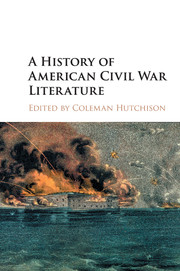Book contents
- Frontmatter
- Dedication
- Contents
- List of Illustrations
- Notes on Contributors
- Preface
- Acknowledgments
- Part I Contexts
- Part II Genres
- Part III Figures
- 12 Walt Whitman
- 13 War and the Art of Writing: Emily Dickinson's Relational Aesthetics
- 14 Herman Melville and the Civilian Author
- 15 Looking at Lincoln
- 16 Frederick Douglass, Violence, and Abraham Lincoln
- 17 Mary Boykin Chesnut: Epic and Miniature
- 18 Mark Twain
- 19 Replay: William Faulkner and the Civil War
- 20 Robert Penn Warren's Civil War
- 21 Natasha Trethewey's Civil War
- 22 Afterword: Archiving the War
- Recommendations for Further Reading
- Index
16 - Frederick Douglass, Violence, and Abraham Lincoln
from Part III - Figures
Published online by Cambridge University Press: 05 December 2015
- Frontmatter
- Dedication
- Contents
- List of Illustrations
- Notes on Contributors
- Preface
- Acknowledgments
- Part I Contexts
- Part II Genres
- Part III Figures
- 12 Walt Whitman
- 13 War and the Art of Writing: Emily Dickinson's Relational Aesthetics
- 14 Herman Melville and the Civilian Author
- 15 Looking at Lincoln
- 16 Frederick Douglass, Violence, and Abraham Lincoln
- 17 Mary Boykin Chesnut: Epic and Miniature
- 18 Mark Twain
- 19 Replay: William Faulkner and the Civil War
- 20 Robert Penn Warren's Civil War
- 21 Natasha Trethewey's Civil War
- 22 Afterword: Archiving the War
- Recommendations for Further Reading
- Index
Summary
The Frederick Douglass that we know from his most famous work – the canonical Narrative of the Life of Frederick Douglass (1845) – is not the Douglass of the Civil War. In his first autobiography, written at a time when he was aligned with the moral-suasionist William Lloyd Garrison, and in his many speeches of the period, Douglass took pains to emphasize the value of nonviolent responses to slavery. Douglass even presented the occasion of his successful resistance to the slave breaker Edward Covey as a self-defensive parrying in which he refused to inflict injury. But beginning in the late 1840s Douglass began to have second thoughts about nonviolence, and by 1851, following his formal break with Garrison, he was regularly asserting that the violence of slavery demanded a violent response. After a fugitive slave hunter was killed in Boston in 1854 when he attempted to remand Anthony Burns into slavery, Douglass remarked: “his slaughter was as innocent, in the sight of God, as would be the slaughter of a ravenous wolf in the act of throttling an infant.” Douglass declared in his 1855 My Bondage and My Freedom that if the slave “kills his master, he imitates only the heroes of the revolution,” and that same year he offered his support for antislavery fighters in the Kansas-Nebraska territories, such as John Brown and his sons. Although Douglass decided not to join what he regarded as Brown's suicidal effort to take the federal arsenal at Harpers Ferry, he boldly endorsed the sort of terroristic violence that Brown had been deploying during the mid-to-late 1850s. As he proclaimed in a speech of 1860 delivered several months after Brown's execution: “we must … reach the slaveholder's conscience through his fear of personal danger. We must make him feel that there is death in the air about him, that there is death in the pot before him, that there is death all around him.”
Douglass's immediate response to the attack on Fort Sumter was to embrace the Civil War as a war of emancipation that would require death way beyond the scale of what Brown had imagined at Harpers Ferry. He hoped and expected that President Abraham Lincoln would share his view that the war was not just about preserving the Union but also about emancipating the slaves.
- Type
- Chapter
- Information
- A History of American Civil War Literature , pp. 242 - 256Publisher: Cambridge University PressPrint publication year: 2015



